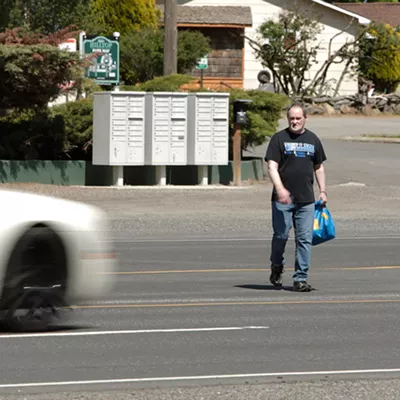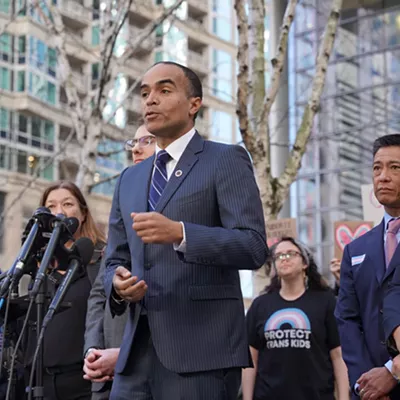Nearly two decades ago, West Central was on the verge of some big changes, with the soon-to-be-developed Kendall Yards area north of the Spokane River bringing both opportunity and the risk of gentrification to the low-income neighborhood's doorstep.
So, in a proactive move in 2007, the Spokane City Council created the West Quadrant Tax Increment Finance District to collect money to put toward revitalization. The move was partly made at the urging of Jim Frank, founder of Greenstone Corporation, the Kendall Yards developer. Frank grew up in West Central and says he has been very intentional about ensuring that Kendall Yards does not turn its back on its neighbors, whether through design or impacts.
"When we began developing Kendall Yards, we really had a focus on making sure the rest of the West Central neighborhood benefited from what was happening," Frank says.
Tax increment financing districts, more commonly called TIFs, aren't exactly well known outside the development realm, but planners say they're an important tool used to invest new tax revenue in a uniquely hyperlocal manner.
Once the boundaries of a TIF are established, the district receives a small percentage of the increased property tax revenue created by development within that area. The idea is to use the money for public improvements, which in turn, hopefully sparks even more investment by private parties.
After years of delayed growth, the West Quadrant TIF is now the city's most active, and the least restricted in terms of the types of projects it could help get off the ground, says Kevin Freibott, a senior planner with the city of Spokane. Public improvements can include things like bike lanes, sidewalks, streetscaping and even affordable housing.
In December, the city signed a contract with the engineering firm Kittelson and Associates to help do outreach in West Central to figure out which projects identified in previous neighborhood plans still have support.
"There's been so many planning studies, and there's a list of projects that are already included as part of the TIF," says Wende Wilber, senior principal planner with Kittelson. "So we started with ... 'Are these still relevant? Are these still of interest to you?' and then, 'What's missing?'"
By the end of this year, the hope is that the consultants, in partnership with the neighborhood, will have a list of eight to 10 shovel-ready projects that can apply for funding from the TIF.
The work is renewing enthusiasm among neighbors who've lobbied for more investment in West Central for years.
"It's hard to get people excited, like, 'Do you wanna hear about a tax increment finance district?' People's eyes glaze over," says Jessie Norris, a homeowner in the neighborhood and secretary for the nonprofit REACH West Central. "There's going to be a lot of money there over time. It really is going to be a big deal."
Fellow West Central resident Liz Morlin, who previously served as neighborhood council president, agrees that it's hard to get people fired up about the financial tool. But she notes that it can empower their neighbors in a way rarely offered to those who can't show up to government meetings.
"This is the ultimate anti-gentrification tool," Marlin says. "It's one of the few opportunities for a low-income neighborhood that hasn't had a lot of investment to receive intentional, targeted investment."

A LITTLE BIT OF HISTORY
Norris says to truly understand why this year's work with Kittelson is such a big deal, you need to know a little history.When the West Quadrant TIF was created in 2007, the revenue was divided into two areas — one for Kendall Yards and one for nearby neighborhoods — and originally set to expire in 2032.
For its part, Kendall Yards agreed to make a series of public upgrades, including building out a portion of the Centennial Trail, in exchange for reimbursement from some of the new property tax revenue generated within the development's mix of commercial and residential buildings.
The other part of the fund was designated for public improvements in the neighborhoods inside the TIF's boundaries, including West Central, a long strip along Monroe Street north into Emerson/Garfield, and a small portion of the Riverside neighborhood downtown.
The district was also created in partnership with Spokane County, which receives 30% of the neighborhood improvement revenue to put toward upgrades to its campus, which is in West Central, city planner Freibott explains.
While all TIFs don't make much money in their first few years, the Great Recession in 2008 did somewhat slow the growth of the neighborhood improvement revenue, Freibott says.
"My husband and I have owned a home in West Central for a very long time — not only did my property taxes not increase during that time, they went down," Norris says. "So there was really no money going into that fund."
Then, in 2019, after the neighborhoods' fund had finally started to build up, the City Council agreed to spend more than half a million dollars from the TIF to update the north suspension bridge in Riverfront Park, and another half a million for utility upgrades in the area that's now home to the Podium.
While the council also approved spending $77,000 to renovate West Central's Dutch Jakes Park at that time, neighbors were unhappy that so much TIF money had gone to projects in areas that were already receiving more than $64 million in publicly funded improvements.
One of the reasons money went to those projects is that they were proposed by city departments that had the expertise to design them and take them to the Neighborhood Project Advisory Committee for approval, Norris says. That committee advises the City Council about which projects to spend the TIF money on (and is currently accepting applications for three open positions).
West Central residents didn't have the same expertise, she says.
In 2020, the neighborhood convinced the city to extend the TIF's expiration date to 2047, to make up for some of the slowdown during the recession. While Spokane County has yet to agree to that extension, once finalized it stands to benefit West Central (and the county) even more, as after 2032 the share of new revenue from Kendall Yards will pour into the neighborhood fund. And half of the money received after 2032 is envisioned to go toward permanent affordable housing.
Now that Kittelson has been hired (with TIF funding), West Central residents will be able to take the lead on where that money goes.
"It's not just the city deciding what gets to happen here," Norris says.
POSSIBILITIES
The West Quadrant TIF already has a list of projects underway that will continue drawing from the neighborhood improvements account, which last week had about $2.3 million in it, Freibott says.Among the approved projects, Habitat for Humanity is purchasing and renovating homes in West Central and creating permanent affordable housing, while the NATIVE Project will receive some help with public utility infrastructure for the new youth treatment center it's building.
Wilber says the Kittelson team is still gathering other ideas and meeting with multiple committees made up of West Central residents this month.
Rather than host open houses, the team has been meeting residents at established community events, such as the neighborhood's spring cleanup day, which offered a captive line of about 70 drivers to talk to while people waited in their vehicles to dispose of trash, Wilber says.
Next, the team plans to speak with residents at the West Central Community Center's Neighbor Day, from 4 pm to 7 pm on Friday, June 7.
"The number one thing that we have consistently heard so far that is not an official project as of yet is infilling of missing sidewalks," Wilber says.
Earlier this spring, the team did a neighborhood walk and imagined what some traffic calming measures could look like, drawing with sidewalk chalk in the street to show the space those "bulb-out" or "bump-out" curb extensions take up.
The team's final concepts to improve the right-of-way will not only be eligible for TIF funding, but could help cover the local share that's needed to qualify for federal safe street grants, Wilber says.
"We're also going to do an economic analysis of what the benefit to the neighborhood and bringing in additional business [is]," Wilber says, "with these improvements of slowing traffic, making it safer to bike and walk, and getting people to transit more easily."
The best part of the project has been seeing how excited everyone is to get closer to seeing some actual concrete and paint, Wilber says.
Marlin, the former neighborhood council president, says the teamwork between the consultant and the neighborhood, rather than a top-down design coming from the city, is revolutionary.
"City staff deserve credit for it," Marlin says. "It's been a long-fought battle to move into this collaborative space."
The goal is to see the funds leveraged for significant change — Marlin notes that West Central leaders have had a running joke for years that they don't want to see hanging baskets installed on Broadway Avenue but nothing fixed for families who are suffering.
"We want to have this kind of investment driven by the neighborhood, rather than inflicted on the neighborhood and displacing people," Marlin says. "Our vision is to maintain and continue to grow this vibrant and sustainable community where everyone can thrive." ♦


























